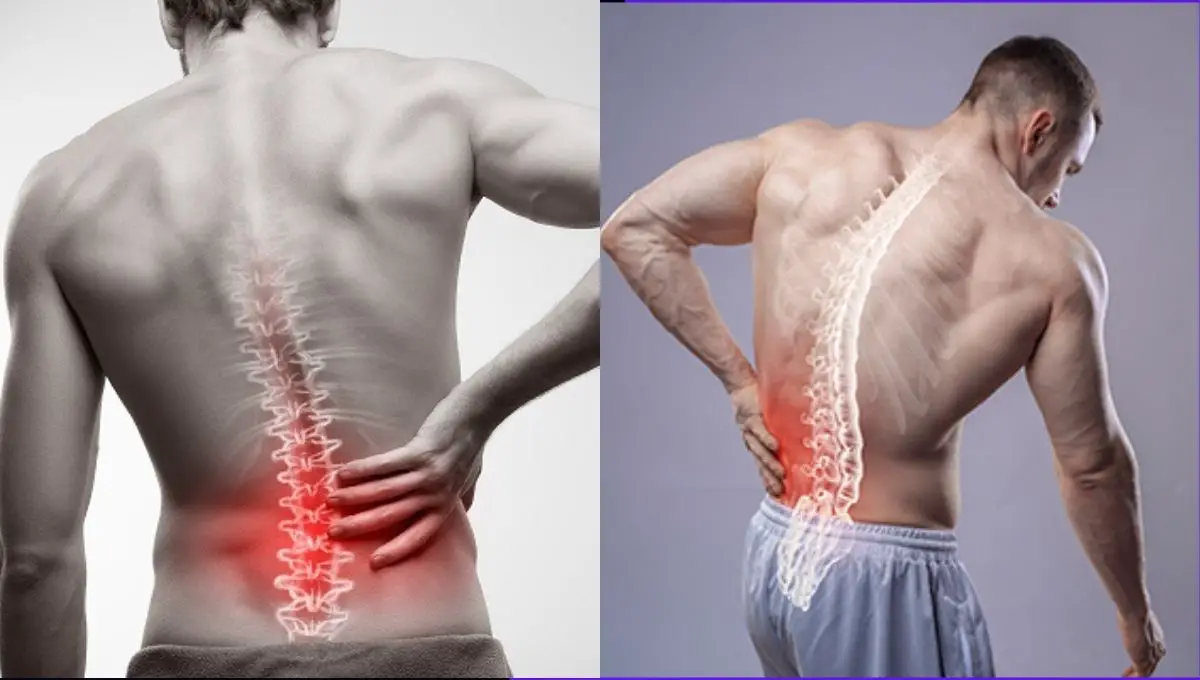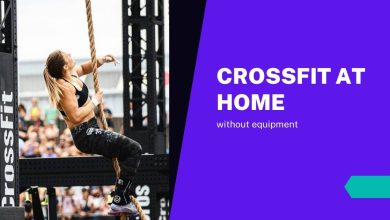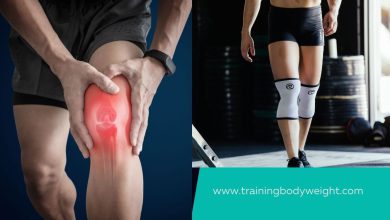CrossFit Back Injury is common among Crossfitters as they often push themselves too hard. Keep in mind that your body needs time to recover after a workout. During the first few weeks of being active, your back is susceptible. It’s best to pay close attention to signs and not push yourself too hard too quickly.
Table of Contents
Why Does Crossfit Back Injury Happen?
Crossfit is notorious for its rate of injuries. According to a study, shoulder and lower back injuries are the most common ones.
In the human body, every part is held by another. Strength and coordination of the whole interconnected system result in a fit and healthy body. There is a progressive curve in fitness until all parts are proportionally strong before increasing the intensity.
Stabilizer muscles, joints, ligaments should reach a certain level of readiness to support our targeted muscle group during the exercise.
Some newbies who hit the gym with little to no physical fitness start with heavy weights. While that weight might suit their targeted muscle, other helper parts and small muscles lag behind. This means vulnerability to improper form during the exercise, which will result in injury. Crossfit back injury pretty often occurs due to incorrect form.
Exercise Mistakes That Cause Crossfit Low Back Injury
Some exercise mistakes are common causes of lower back pain in various exercises, including CrossFit.
1. Skipping Warm-up Before the Workout
When muscles are inactive for a while, they become inflexible. Therefore, when they are exposed to sudden pressure they tear, which can be a common cause of Crossfit back injury. Warming up before the exercise causes muscles to be flexible and decreases the risk of damage.
2. Starting with Heavy Weights or Intense Exercises
There is no doubt that in order to progress in fitness, you need to challenge yourself beyond your limit. However, it takes time to become adept at the proper form and muscular readiness if you are a beginner. At this stage, it is better to exercise with moderate weight or intensity until you build a suitable foundation for advanced exercises. It is a critical period in which trainees can experience Crossfit back injury.
3. Having Improper Form Can Lead to Crossfit Back Injury
A straight spine that is stable during the exercises can prevent lots of Crossfit low back injuries. Especially for lower body exercises, it is crucial to maintain a proper form. Gym belt is necessary for many lower-body activities such as squats and deadlift. It holds the spine erect and prevents surplus movements of the lower back during the lift.
4. Escaping Post-exercise Cool down and Stretch
Stretching after a vigorous exercise helps with Crossfit back pain relief. The accumulation of lactic acid in the muscles can cause soreness and fatigue after the workout. Active stretching and cooling down after the exercises help with the cleansing of lactic acid, and reduce soreness.
5. Continuous stress on the Same Part Can Lead to Crossfit Back Injury
An injury does not always happen due to sudden intense stress on the part, but sometimes because of repetitive stress on the same part over time. Continuously overstressing the same muscle group and not others creates imbalance that gradually leads to injury. Tennis elbow is a perfect example of this type of injury. Crossfit spine injury can also happen due to repetitively stressing back muscles without paying attention to the core strength as a whole.
Suggestions Below Can Help to Prevent Crossfit Spinal Injury

Don’t Work Through a Crossfit Back Pain
Pressing further with a bad back can aggravate the damage. If it hurts while bending backwards, don’t do it.
Whatever exercise you do, you should stop doing it if it feels painful. Change your exercise plan, and don’t continue that move.
You may think that you have recovered from a Crossfit back injury but suddenly feel pain down your legs or even numbness or tingling. These are the signs that you should take seriously. Seek medical care if you notice these types of symptoms, as they may lead to something serious.
Build a Proper Foundation to Prevent Crossfit Spine Injury
Always follow your routine to build a proper foundation for advanced exercises. Especially if you are crossfitting with a bad back, set your workout routine based on the situation and stick to it. Random and unexpected pressure can cause damage to the tissues; fitness is a process.
Assess your physical conditions and adjust your routine based on that. If you have an injury, even a past injury, that area may still be vulnerable to damage.
Strengthening Core Muscles Prevents Lower Back Pain from Crossfit
Strong core muscles support your spine and prevents extra movements on the part. They keep the spine in condition and prevent unwanted movements under pressure.
Core muscles also help transfer the pressure through muscles rather than all through the spine. This reduces the risk of Crossfit spinal injury.
Back muscles hold vertebrae aligned and keep spinal joints in a stable position. Abdominal muscles support a proper spinal curvature and pelvic tilt, which is important for the stabilization and prevention of Crossfit spinal injury. Contracting abdominal muscles lift a portion of the pressure from the spine.
Apart from abdominal muscles, other muscles are also crucial in preventing Crossfit back injury. For example, strong hip muscles help with balance, and glute muscles stabilize hip joints. Both groups of muscles support the lower back during the exercise.
Core muscles include the abdominal, back, hip, glutes, and pelvic muscles. They work synergetically during the exercise, and strengthening the area can keep you from Crossfit lower back injury.
Avoid These Exercises with Crossfit Lower Back Injury
While we can recommend all types of exercises for healthy people, specific activities can aggravate a Crossfit bad back.
1. Avoid Sit-ups, Do partial Sit-up Instead
Sit-ups are favorite exercises for strengthening abdominal muscles in various methods, including Crossfit bodyweight workout. In case of Crossfit spinal injury, they can also put strain on disks in your spine. Most people tend to engage hip muscles while doing sit-up. Partial crunches are safer to strengthen stomach muscles without straining a bad back.
To do partial sit-up, lie on the floor with feet touching the floor and slightly bent knees. Put your hands on your chest in a cross shape, or put them behind your neck. With the contraction of abdominal muscles, lift your shoulders off the ground. Hold in that position for a few seconds and slowly bring shoulders down on the floor. Simultaneously exhale as you raise shoulders and inhale while lying back down. Repeat it in 3 or 4 sets of 8-12 repetitions.
Read about different ranges of sets and reps in efficient hypertrophy sets with bodyweight.
Pay attention that you should lift shoulders with contracting stomach muscles. Don’t try to pull your neck with your hands or lead the movement with elbows. It can place strain on your Crossfit back injury. The lower back and feet should remain on the floor throughout the exercise. Maintaining a proper form will prevent the worsening of a Crossfit bad back.
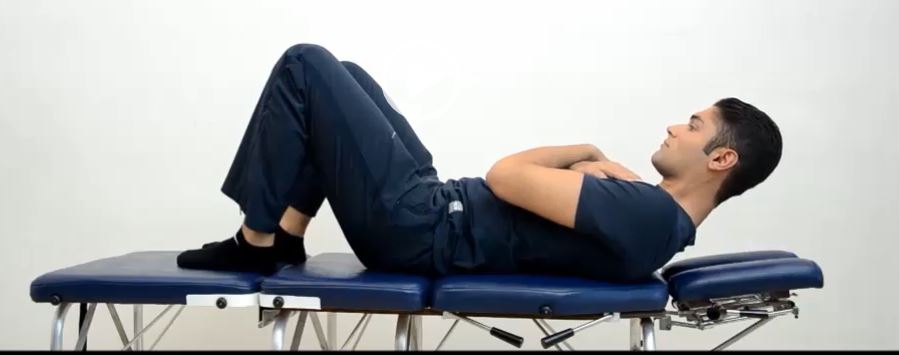
2. High Impact Aerobics Can Aggravate Your Crossfit Back Injury
Crossfit lower back injury rehab can involve low-impact aerobics. However, you should avoid high-impact aerobics such as running. Exercises that send shock to the spine or twist it are other examples.
3. Standing Toe Touches
Stretching exercises after the workout and during the cool-down are recommended to prevent muscle soreness and help with recovery. Also, during a warm-up stage, it can help loosen stiff muscles such as hamstrings, since they can be conducive to back pain.
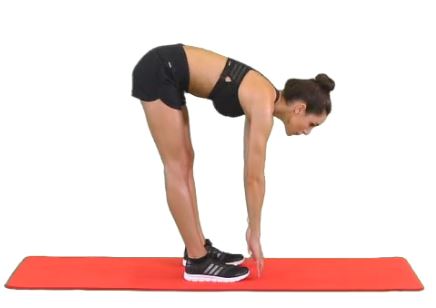
Nevertheless, standing toe touch can stretch back more than the hamstrings. In case of Crossfit lower back injury, this stretch can aggravate the back pain.
Instead of standing toe touch, try hamstring stretch with a towel.
- Lie on the floor in a relaxed state.
- Place a towel behind your foot.
- Gently pull the towel towards your chest; make sure you feel the stretch in the hamstring.
- Hold in that position for 30-60 seconds.
- Lower the leg to its initial state.
- Repeat 3 to 5 times.
- Repeat with another leg.
Some therapists do this hamstring stretch for their patients. Instead of using a towel, the therapist raises the leg. The advantage of using a towel is that you can feel the stretch and decide when it is enough.
4. Exercises That Involve Spinal Twist
Some exercises put emphasis on flexibility and stretching movements. Nonetheless, you should be cautious when you are inflicted with a Crossfit back injury.
Yoga improves flexibility, but you should avoid exercises like spinal twists and forward folds with a Crossfit spinal injury. Twisting movements can exacerbate an existing back injury.
Listen to your body while doing these types of movements. Learn the proper form and do not continue when a movement doesn’t feel right. Particularly in yoga, some exercises can be modified to fulfill the needs of individuals. Make sure you communicate your condition with your instructor.
5. Avoid Superman Back Extension, Perform Bird-Dog Instead
For superman back extension, you lie face down on the ground. Then lift your legs and arms simultaneously off the ground and hold in that position for a few seconds. This exercise can put stress on a Crossfit spinal injury.
Alternatively, try bird-dog that is less harmful to your Crossfit spinal injury and can help to strengthen and stabilize your lower back.
- Start on your hands and knees,
- Raise one leg and extend it at core level.
- Engage your abs throughout the exercise. The pelvis should remain stable during the move.
- Raise your opposite arm until it is aligned with the core.
- Hold on for a few seconds and bring your arm and leg to the initial state.
- Repeat for 8 – 12 times.
- Try with another arm and leg.
Types of Crossfit Back Injuries
Lumbar Strain Crossfit
Lumbar strain is a prevalent injury for the lower back. Lifting weight with improper form can result in CrossFit back injuries. Sometimes due to bad form stabilizing muscles of the spine are stretched too much. As a result, tiny tears happen in the tissue, weaken them and make the spine less stable.
Some symptoms can be pain, spasm, rigidity, and soreness. Using a back support brace can help prevent Crossfit back injuries. It stabilizes the vertebral column and keeps the back warm.
Crossfit Sciatica Pain
Sciatica pain starts from the sciatica nerve and shoots down to the lower back and all the way down the feet; It is usually felt in a single side of the body. It is caused by the tension being placed on the nerve. Some other symptoms include numbness, tingling, or weakness in the aforementioned parts. A sciatica back pain from Crossfit can be due to slipped vertebrae. Sciatica can happen all of a sudden but progress gradually.
What are the 4 Ways to Prevent Crossfit Sciatica Pain?
- Exercise regularly and keep core muscles ready.
- Sit in proper posture. Your seat should support your lower back and allow a natural small of the back.
- Don’t sit for long periods at once.
- Maintain a proper posture in standing, sitting, or during exercise.
Crossfit Herniated Disc
Spinal discs produce a cushioning effect between vertebrae. They facilitate movements of the spine. Overstressing these discs can damage them, and this can be another cause of Crossfit spinal injury. Lifting heavy weights like in deadlift or squat without a proper control over the movement can damage them. Herniated disk can also be another cause of sciatica.
Sometimes they swell out or break if too much pressure is applied to them. A ruptured or popped out disc can be painful since it presses the nerves. Sometimes it leads to numbness, losing balance, muscle function, or bladder control which requires medical attention.
How Can You Tell if You Slipped a Disc?
Common symptoms of a slipped disc include:
1. Numbness or pain on one side.
2. A feeling of pain that runs to the extremities (sciatica).
3. Pain exacerbates in certain activities like bending forward, pushing or pulling something, lifting something.
4. Tingling or burning sensation in the area.
Crossfit Hip Flexor Pain
Stiff iliopsoas or stiff hip flexors can cause back pain. The iliopsoas muscle is another name for hip flexors. They are two muscles: iliacus muscle and psoas muscle, separated in the abdominal area and united in the thighs.
Sometimes we tend to be inactive in a sitting position for hours due to our daily jobs and then hit the Crossfit gym and lift heavy weights. Long hours of sited position set hips and leg muscles in a flexed state. As a result, hip flexors become stiff, and you will likely suffer Crossfit back pain on a regular basis.
Tightness and stiffness of hip flexors lead to a limited range of motion and subsequently lower back pain.
Messaging the area, some stretching moves in hamstring and glutes, holding for a few seconds in lunge position, and particularly some yoga techniques can help to release the tightness of the iliopsoas.
Further reading:
